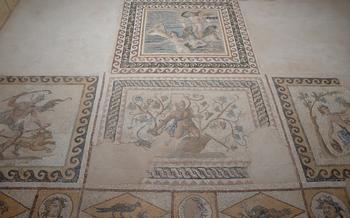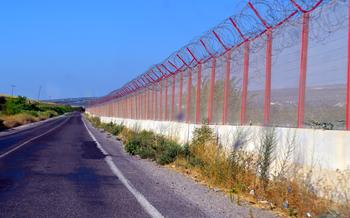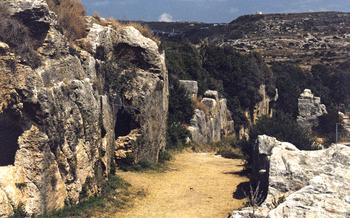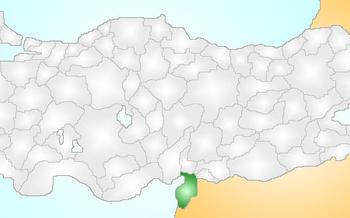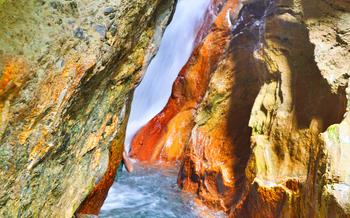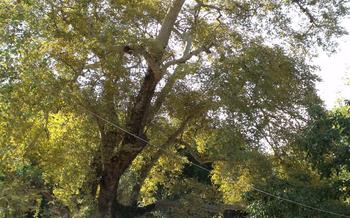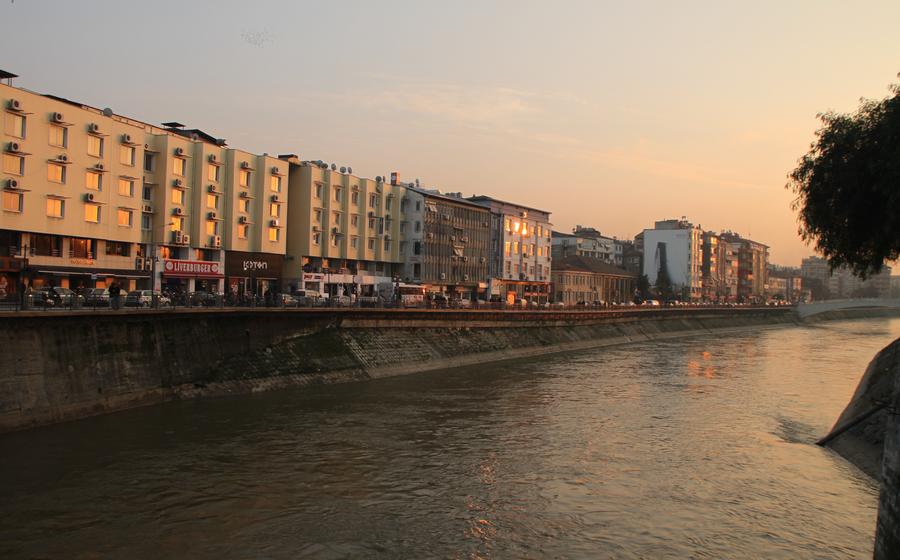
Elephant Rock (Vespasianus Titus Tunnel)
- History of the Elephant Rock (Vespasianus Titus Tunnel)
- Location of the Elephant Rock (Vespasianus Titus Tunnel)
- The Elephant Rock Formation
- The Hidden Chamber (Cave)
- Exploring the Tunnel
- The Water System
- The Roman Road
- The Village of Vakifli
- Best Time to Visit
- Entrance Fees and Hours of Operation
- What to Bring
- Things to See and Do Nearby
- Tips for a Memorable Visit
- Insider Tip: Unveiling the Hidden Treasures
History of the Elephant Rock (Vespasianus Titus Tunnel)
The Elephant Rock, also known as the Vespasianus Titus Tunnel, stands as a testament to the rich history and engineering prowess of the Roman Empire. Constructed during the reign of Emperor Vespasian in the 1st century AD, this impressive tunnel served as a vital water supply route for the ancient city of Antioch, ensuring a steady flow of water to its inhabitants. The tunnel's strategic importance is further underscored by its connection to the renowned Roman Road, a testament to the empire's extensive infrastructure and trade networks.
Beyond its practical function, the Elephant Rock is steeped in legend and folklore. According to local lore, the tunnel was once home to a colossal elephant, revered by the people of Antioch for its wisdom and strength. While the presence of an actual elephant may be a matter of myth, the Elephant Rock's distinctive shape, reminiscent of an elephant's head, has immortalized the legend, making it an enduring symbol of the region.
In recent years, archaeological excavations at the site have unearthed a wealth of artifacts and inscriptions, shedding new light on the tunnel's construction and purpose. These discoveries have confirmed the tunnel's role as a crucial water supply system, as well as its significance as a sacred site, frequented by pilgrims and worshippers seeking blessings and divine intervention.
Location of the Elephant Rock (Vespasianus Titus Tunnel)
The Elephant Rock, also known as the Vespasianus Titus Tunnel, is situated in the ancient city of Seleucia Pieria, within the boundaries of the Hatay province of Turkey. It is situated on the southeastern coast of the country, approximately 25 kilometers (5 miles) south of the city of Antakya. The exact geographical coordinates of the site are 36 degrees 05' 39" N, 36 degrees 10' 04" E. The Elephant Rock is easily accessible by public transportation, with regular buses departing from Antakya to Vakifli, the village located closest to the site. From Vakifli, a short walk or taxi ride will take you to the entrance of the tunnel.
Nearby landmarks and attractions include the ancient city of Seleucia Pieria itself, with its well-preserved Roman theater and other ruins. The city of Antakya, with its rich history and cultural heritage, is also worth exploring. The stunning Mediterranean coastline, with its beautiful beaches and picturesque towns, is just a short drive away.
The Elephant Rock Formation
The Elephant Rock, towering over the landscape, is a geological marvel composed primarily of limestone. Its unique shape, resembling an elephant, has captured the imagination of visitors throughout the ages. This impressive natural formation is the result of millions of years of erosion and weathering. Water, wind, and other natural forces have sculpted the rock, creating the distinct contours that evoke the form of an elephant. The rock's distinctive appearance has earned it the name "Elephant Rock," and it has become a symbol of the region, representing its rich natural heritage and geological wonders. The Elephant Rock stands as a testament to the power of nature and the beauty that can arise from the forces that shape our world.
The Hidden Chamber (Cave)
The Elephant Rock also boasts a hidden chamber, a secret room concealed within its depths. The existence of this chamber remained unknown until its chance discovery during archaeological excavations. The purpose of the chamber is still shrouded in mystery, but scholars speculate that it may have served as a storage space or a shelter during times of danger.
Inside the hidden chamber, archaeologists have uncovered a wealth of artifacts and inscriptions, providing valuable insights into the history and significance of the site. These artifacts include ancient pottery, tools, and religious objects, all of which shed light on the daily lives and beliefs of the people who once inhabited this region.
Exploring the hidden chamber requires caution and safety precautions, as the space is often narrow and dimly lit. Visitors are advised to wear appropriate footwear and clothing, and to bring a flashlight or headlamp for better visibility. Guided tours are available for those who wish to learn more about the history and significance of the chamber, while self-exploration is also an option for adventurous travelers.
Exploring the Tunnel
The Vespasianus Titus Tunnel, an awe-inspiring feat of ancient engineering, invites visitors to embark on a journey through time. Measuring an impressive 138 meters in length and 6 meters in width, the tunnel's imposing dimensions are a testament to the ingenuity of its Roman builders. As you venture into the depths of the tunnel, intricate carvings and niches adorn the walls, providing glimpses into the artistry and craftsmanship of the past.
The tunnel's interior is dramatically illuminated, casting an ethereal glow on its weathered surfaces. This atmospheric lighting enhances the sense of mystery and wonder that surrounds this ancient passageway. Visitors can choose to explore the tunnel independently or join a guided tour, led by knowledgeable experts who bring the tunnel's history and significance to life.
Safety measures are meticulously implemented to ensure a secure and enjoyable experience for all visitors. Anti-slip walkways and sturdy handrails line the tunnel's path, providing ample support and stability. Additionally, emergency exits are strategically placed along the route, guaranteeing a swift evacuation in case of any unforeseen circumstances.
Whether exploring solo or as part of a guided group, the Vespasianus Titus Tunnel promises an enriching and immersive experience that transports visitors back to the grandeur of the Roman Empire.
The Water System
The Elephant Rock (Vespasianus Titus Tunnel) was not just a tunnel but also an integral part of an ancient water management system that supplied water to the region. The Romans, known for their engineering prowess, built a sophisticated network of aqueducts and channels to harness the natural water sources and distribute water to their settlements.
The water that flowed through the tunnel originated from the nearby mountains and was collected in reservoirs. From there, it was channeled into the tunnel and transported over long distances. The tunnel acted as a conduit, allowing water to flow smoothly and consistently, even through challenging terrain.
The water system was crucial for the survival and prosperity of the region. It provided water for drinking, irrigation, and other domestic purposes. The Romans' expertise in water management enabled them to sustain their settlements, promote agriculture, and maintain a high standard of living.
Today, the water system is no longer functional, but its remnants are still visible within the tunnel. Visitors can observe the channels and conduits that once carried water, and appreciate the ingenuity of the ancient Romans who harnessed nature's resources to meet their needs.
The Roman Road
The Elephant Rock (Vespasianus Titus Tunnel) is not just a marvel of ancient engineering but also a testament to the vast network of roads that crisscrossed the Roman Empire. This tunnel was an integral part of a Roman road that connected the cities of Antioch and Seleucia Pieria, two of the most important urban centers in the region.
The construction of this road was a testament to the Romans' prowess in engineering. They skillfully carved a path through the rugged terrain, ensuring a safe and efficient passage for trade and travel. The road was wide enough to accommodate multiple carts and wagons, facilitating the transportation of goods and people.
Remnants of this ancient Roman road can still be seen in the vicinity of the Elephant Rock. These cobbled sections, worn by centuries of use, evoke a sense of awe and wonder at the enduring legacy of the Roman Empire. They stand as a reminder of the vast infrastructure projects that once connected the far-flung corners of their vast domain.
Exploring these remnants of the Roman road is like stepping back in time. One can almost imagine the hustle and bustle of trade caravans and the steady march of Roman legions along this vital artery of the empire. The road tells a story of connectivity, commerce, and the enduring influence of Roman civilization.
The Village of Vakifli
In the immediate vicinity of the Elephant Rock, the charming village of Vakifli awaits exploration. Steeped in history and local traditions, Vakifli offers a glimpse into the vibrant culture of Hatay. Take a leisurely stroll through its narrow streets, where time seems to stand still, and admire the traditional architecture that adorns the village. Engage with the friendly locals, who are always eager to share stories and anecdotes about their beloved village.
Vakifli is an ideal base for travelers seeking an authentic cultural experience. Immerse yourself in the local way of life by visiting the bustling market, where vendors showcase an array of fresh produce, handmade crafts, and local delicacies. Indulge in the flavors of traditional Hatay cuisine at one of the village's cozy restaurants, where you can savor mouthwatering dishes prepared with fresh, local ingredients.
For those seeking a deeper connection with the community, Vakifli offers opportunities for cultural immersion. Participate in traditional cooking classes, where you can learn the secrets of Hatay's culinary heritage. Engage in lively conversations with the villagers, who are passionate about sharing their customs and traditions. With its warm hospitality, rich culture, and stunning surroundings, the village of Vakifli promises an unforgettable experience for travelers seeking a true taste of Hatay.
Best Time to Visit
The best time to visit the Elephant Rock and the surrounding area is during the spring (April-May) and autumn (September-October) months. The weather is mild and pleasant, making it ideal for outdoor exploration. Summer (June-August) can be hot and crowded, while winter (November-March) can be cold and rainy, although it does offer a unique perspective on the landscape.
If you're interested in attending special events or festivals, check the local calendar before your trip. The Hatay region is known for its vibrant cultural heritage, and there are often celebrations and events throughout the year.
To avoid peak tourist season and enjoy a more intimate experience, consider visiting during the shoulder seasons (May-June and September-October). The weather is still favorable, but there are fewer crowds, making it easier to explore at your own pace and capture stunning photos without distractions.
Entrance Fees and Hours of Operation
Admission to the Elephant Rock (Vespasianus Titus Tunnel) is subject to a modest entrance fee. This fee helps maintain the site's upkeep, preservation, and ongoing research efforts. The current admission price for adults is [amount], while children and students enjoy a discounted rate of [amount]. Family tickets and group discounts may also be available.
The site's operating hours are generally consistent throughout the week, but it's advisable to check the official website or local tourist information centers for any seasonal variations or special arrangements. Typically, the Elephant Rock is open to visitors from [time] to [time], [days of the week]. Public holidays may have different hours or closures, so it's best to plan accordingly.
Advance booking is not mandatory, and tickets can be purchased on-site at the entrance. However, during peak tourist season or for larger groups, it might be prudent to reserve your tickets in advance to avoid long queues. Online booking platforms or contacting the local tourism board can provide information on advance purchase options.
What to Bring
When preparing for your visit to the Elephant Rock, it's essential to come equipped with a few key items to ensure a comfortable and enriching experience. First and foremost, bring plenty of water, as the tunnel can be humid and warm. Comfortable clothing and sturdy footwear are also recommended, as you'll likely be doing some walking and exploring.
To capture the beauty of the site, consider bringing a camera or smartphone with a good lens for taking photos. A flashlight or headlamp can also be useful for navigating dimly lit areas of the tunnel. If you plan on spending a significant amount of time exploring, snacks and a light meal are advisable.
Finally, remember to bring a sense of curiosity and wonder. The Elephant Rock is a place steeped in history, culture, and natural beauty, so be open to learning about its significance and marveling at its unique features. Embracing the spirit of discovery will enhance your overall experience and create lasting memories.
Things to See and Do Nearby
The Elephant Rock and the surrounding area offer a wealth of additional attractions for visitors to explore. History buffs can delve deeper into the region's rich past at the Hatay Archaeology Museum, which houses a vast collection of artifacts from various civilizations that have called this land home. Nature enthusiasts will be captivated by the stunning Karasu Waterfall, a cascading wonder set amidst lush greenery, inviting visitors to take a refreshing dip in its cool waters.
For those seeking a unique shopping experience, the bustling Antakya Bazaar is a must-visit. Here, one can haggle for traditional Turkish handicrafts, savor the flavors of local spices, and indulge in the vibrant atmosphere of this centuries-old marketplace. And no trip to Hatay would be complete without sampling the region's renowned cuisine. From the mouthwatering flavors of künefe, a sweet cheese pastry soaked in syrup, to the savory delights of hummus and kebabs, Hatay's culinary scene is guaranteed to tantalize taste buds.
Tips for a Memorable Visit
To make the most of your visit to the Elephant Rock (Vespasianus Titus Tunnel), plan to spend at least two to three hours exploring the site. This will give you ample time to walk through the tunnel, admire the rock formation, and delve into the history and legends surrounding it.
Consider hiring a local guide for a more enriching experience. They can provide insights into the historical significance, architectural features, and cultural importance of the site. Their knowledge will bring the history of the tunnel to life and help you appreciate the nuances that might otherwise go unnoticed.
Remember that the Elephant Rock is a culturally significant site, so be respectful of the local customs and traditions. Dress modestly and avoid loud or disruptive behavior. Take the opportunity to interact with the local people and learn about their way of life.
To avoid the crowds and capture the essence of the place, visit during the shoulder seasons (spring and autumn) or on weekdays. This will allow you to explore the tunnel and its surroundings at a more leisurely pace and enjoy moments of solitude amidst the ancient ruins.
Insider Tip: Unveiling the Hidden Treasures
Venturing beyond the beaten path of the Elephant Rock, you'll discover a treasure trove of hidden gems waiting to be unearthed. For a breathtaking panorama, ascend the nearby hilltop, where you'll be rewarded with sweeping views of the surrounding landscape. As you explore, keep an eye out for concealed nooks and crevices that may reveal ancient inscriptions or remnants of past civilizations. Engage with the friendly locals, who will gladly share stories and insights into the region's rich cultural heritage. Embrace the opportunity to savor authentic Turkish cuisine at local eateries, where you can indulge in mouthwatering dishes that reflect the region's unique culinary traditions. Before departing, don't forget to pick up some distinctive souvenirs from local artisans, each piece carrying a touch of Hatay's vibrant culture.
